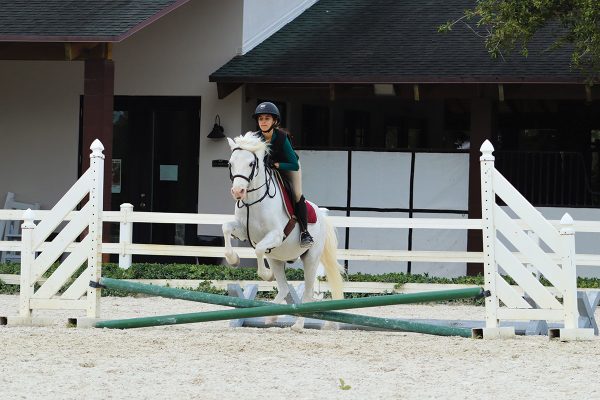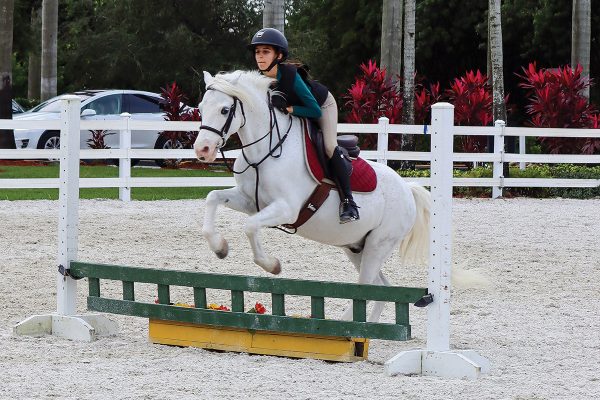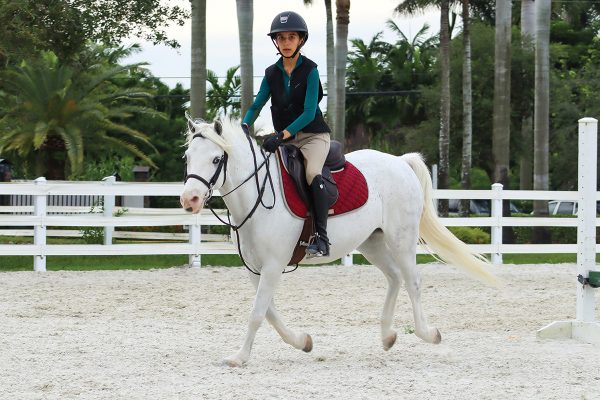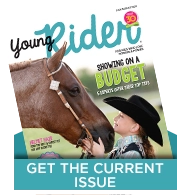If you don’t get to take frequent lessons, you may find the need to practice what you’ve learned in between without your instructor presents. This key jumping exercise is the perfect one to try to help you and your horse master several skills at once. For safety’s sake, always have your parents’ permission, and ideally they can be there to watch you. If not, always have a barn buddy there as your extra set of eyes.
In particular, jumping without your instructor can be overwhelming. To help make it easier, pick one or two main things to focus on so that your ride has a purpose.
When setting up the jumps, make them smaller and simpler than what you usually jump in lessons so that the jumps are not the main concern. After all, when jumping a course, you could have 100 canter strides and only eight of them are over the jumps. When you focus on the other details, the jumps just happen.
Jumping Requires Math!
A great way to keep jumping simple is by focusing on a line. For this jumping exercise, it’s best to set up down the centerline of your riding space so that you and your horse get to work evenly in both directions.

It’s very important to know how long your horse or pony’s stride is and to measure the distances with a tape measure. If you aren’t sure how long your horse or pony’s stride is for trot poles and while cantering, ask your instructor. Most horses require 4.5 feet between trot poles and have a 12-foot canter stride, but some are shorter-strided. Ponies can require anywhere from 3 to 4.5 feet between trot poles and have a 9 to 12-foot canter stride.
Using the correct measurements for your horse, set two or three trot poles leading up to a cross-rail. The distance between the last pole and the cross-rail should be double the distance you set between poles.
For example, if your poles are 4 feet apart, the last pole before the cross-rail should be 8 feet before the cross-rail. Next, set a small vertical (or another cross-rail if that’s more comfortable for you and your mount) six or seven strides after the cross-rail. If space is more limited, you may want to make a five-stride line instead.
In order to know how many feet you need to measure between the two jumps, multiply your horse’s stride length by the number of strides you want. For example, if your pony has a 10-foot stride and you want to make a six-stride line, 10 x 6 = 60 feet between the first jump and the second.
When you are ready to canter into a line of two jumps, add one to the number of strides desired, since takeoff and landing will each fill a half stride. Your six-stride line is now 10 x 7 = 70 feet for the pony’s stride in this example.
Impulsion and Straightness
After you and your horse have warmed up by walking, trotting, and cantering, you’re ready to start the exercise. The first focus point of this exercise is impulsion. Impulsion is the feeling that the horse has lots of good, springy energy in his gait.
To achieve this on a lazier horse, you may need to kick, cluck, tap him behind your leg with a crop, or all of the above! You’ll need to come to the poles and cross-rail with plenty of impulsion so you can land from the jump cantering.
You don’t want to plop over the jump trotting and then have to chase your horse up into the canter after you land. The feeling you are looking for is your horse pushing off for the cross-rail using his hindquarters, and using that pushing energy to create the canter.
Once you land from the cross-rail, keep your eyes focused on the second jump. The goal is to keep your horse as straight as possible and jump in the center. On the landing of the second jump, stay straight for a few strides until you feel whether your horse is on the left lead or the right lead.

Correct Lead
As you know from flatting, the leading leg in the canter is the shoulder that reaches out further during the canter stride. If you’ve been riding for a while, you will likely be able to feel this. If you can’t feel it, try looking down quickly, like when you check your diagonals, to see which shoulder is reaching further forward.
If you can’t feel your leads, take note that you have some homework to do. During one of your next rides, spend time at the walk feeling when your horse reaches forward with each shoulder. This will give you something to refer to next time you try to feel your leads at the canter. Feeling your lead is an important part of coursework, since it will let you know whether a lead change is needed.

Once you have identified your lead, turn in the direction of your lead, canter back toward the beginning of the exercise, come down to the trot, and come through again.
What If My Horse Wants to Rush?
If your horse or pony sees the second jump and wants to rush, it’s totally OK to quietly circle in the direction of your lead in the middle of the line or bring him back down to the trot. Either one of these corrections will allow you to practice the main principles of this jumping exercise an extra time.
Circling gives you another chance to try and feel your lead, and trotting the second jump and landing in the canter allows another chance to practice creating impulsion.
It’s important to recognize a job well done, and once you and your mount have gotten the hang of it, it’s time to stop for the day. If for some reason you or your horse are continuously struggling with something in this jumping exercise, be sure to ask your instructor about it at your next lesson.
About the Model
Lily Epstein, 13, lives in Coral Gables, Fla., and rides with Hanae Leeman of Forever Equestrian. She began her love of riding at a very young age during summers in Utah, and started riding year-round at age 6.
Lily now rides ponies of all sizes, as well as a horse named Fiat. She has ridden Fiat in the Taylor Harris Insurance Services medal and children’s divisions with national recognition. The biggest highlight of her riding career so far was Pony Finals 2021, where she won the smalls division with her pony, Pepsi.
This article about a key jumping exercise appeared in the May/June 2022 issue of Young Rider magazine. Click here to subscribe!


